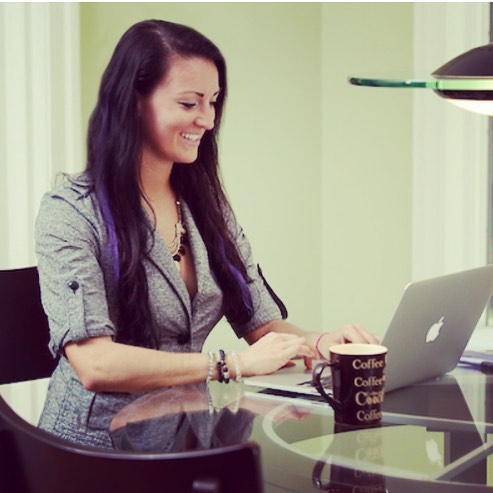Today’s guest post comes courtesy of SUNY Cortland head strength coach and lecturer, Justin Kompf. And speaking of SUNY Cortland, the annual Health and Wellness Conference is this April 8th featuring myself, Dr. Lisa Lewis, Brian St. Pierre, Mark Fisher, and Dr. David Just. For more information go HERE.
It is the easiest thing in the world to sit down after work, turn on the television and eat whatever food is most convenient.

This convenience is inherently pleasurable; for most people, alternative behaviors such as exercise and cooking for 30 minutes are not. There is no immediate reward to experience from this type of behavior.
In fact, the exercise session may actually elicit what is perceived to be painful bodily experiences, especially when compared to sitting on the couch. The chicken and broccoli meal certainly isn’t going to excite your taste buds in the same way that burger, fries, and milkshake would. Thus, there is potential for painful experiences such as bodily discomfort and future soreness when a person exercises and they are also giving up the pleasure associated with unhealthy food.
Change Is Difficult
Due to the general difficulty of change, lifestyle modification to adopt healthier behaviors will certainly result in struggling with some intrinsically negative emotions. Struggling to suppress or avoid thoughts such as “I won’t eat the cookie” or “I won’t sit on the couch and watch television after work” might actually make these thoughts more accessible in the mind and ironically more likely to occur. Additionally, if you are trying to eat healthier and exercise more and happen to have a normal human mind, you will inevitably have negative self-thoughts.
“No matter how hard I work, I will never look like her”
“Exercising every day is challenging with my schedule, is it even worth it?”
“I can’t do it”
“I can’t change”
“I’ve failed at this before, why should now be any different?”
“I didn’t lose weight this week, I’m a failure”
If we are to avoid the suppression of these thoughts, which will bubble into our heads regardless of how strong our willpower is, the logical converse is acceptance. To quote Russ Harris in his book ACT made simple: An Aasy-to-Read Primer on Acceptance and Commitment Therapy:
“Acceptance means opening up and making room for painful feelings, sensations, urges, and emotions. We drop the struggle with them, give them some breathing space, and allow them to be as they are. Instead of fighting them, resisting them, running from them, or getting overwhelmed by them, we open up to them and let them be. (Note: This doesn’t mean liking them or wanting them. It simply means making room for them!)”
When these negative thoughts appear in your head ask yourself the question, “Can I work with these thoughts?”. It is not a question of whether these thoughts are true or false since this is all a matter of perspective.
For example, “I didn’t lose weight this week, I’m a failure”. Whether or not your truly are a “failure” is irrelevant. What is relevant is how this thought will guide your behavior. If you let the thought of being a failure guide your behavior will it enable you to reach your goals and help you become the kind of person you want to be?
Copyright: wollertz / 123RF Stock Photo
Acceptance and commitment based strategies may be useful in promoting physical activity. Pilot research on the topic demonstrated that after an acceptance and commitment based intervention college aged women visited the school athletic center to exercise significantly more than those in an education only condition (Butryn, et al., 2011).
Further, after a 10-week study designed to promote increased walking in sedentary individuals, Martin and colleagues found that when participants were taught skills to enable the acceptance of negative feelings and unpleasant sensations that come with physical activity there was a significant increase in cardiorespiratory fitness, estimated VO2max, and a decreased avoidance of the negative internal experiences related to physical activity (no control group for comparison).
One weight loss study showed that after a 12-week acceptance based intervention participants lost 6.6% of their body weight. More impressively, at a six month follow up participants had continued to lose weight (9.6% of body weight) (Forman, 2009).
Two of the most practical tips to practice acceptance and commitment are to identify higher order values and to examine if thoughts are workable.
Let behaviors be guided by values rather than ruminating on negative thoughts
Acceptance and commitment therapy is based on the understanding that people will only continue to engage in behaviors that bring about distressing internal experiences only if these experiences are occurring at the service of some higher order life goal or value.
In their 2009 Pilot study Forman and his colleagues had participants list out the top 10 reasons why they wanted to lose weight. They were then taught to recognize the connection between the values they listed and their eating and physical activity behavior (Forman, 2009). Once higher order values are identified, meaning is now attributed to daily behaviors that once lacked importance.
I believe that this connection between behaviors and values is best exemplified by Hall of Fame pitcher Tom Seaver:
“Pitching…determines what I eat, when I go to bed, what I do when I’m awake. It determines how I spend my life when I’m not pitching. If it means I have to come to Florida and can’t get tanned because I might get a burn that would keep me from throwing a few days, then I never go shirtless in the sun… If it means I have to remind myself not to pet dogs with my left hand or throw logs on the fire with my left hand, then I do that, too. If it means in the winter I eat cottage cheese instead of chocolate chip cookies in order to keep my weight down, then I eat cottage cheese.” (Duckworth)
A value system establishes that low order daily behaviors are in service of higher order long term goals. If you need more help finding strong values to strengthen your resolve for daily behaviors try asking yourself why each stated goal is important to you. For example:
Goal level 1: I want to start exercising more consistently. Why?
Goal level 2: Because I want to improve my health. Why?
Goal level 3: Because I have seen unhealthy relatives lose their independence with age and I want to be able to do all the activities I love for a long time.
Exercising consistently is thus linked to being able to maintain one’s independence throughout a lifetime.
Ask if your thoughts are workable
Whenever a negative thought or feeling comes into consciousness ask yourself if this thought is workable. Specifically, you can ask yourself the following:
“If you let this thought guide your behavior, will that help you create a richer, fuller, and more meaningful life? If you hold on to this thought tightly, does it help you to be the person you want to be and do the things you want to do?”
Copyright: gajus / 123RF Stock Photo
If this thought is not workable, try practicing an acceptance based skill called defusion. Defusion is the process of observing thoughts and feelings from a ‘distance’ without acting on them or trying to change them. Thoughts and feelings do not need to be believed, acted on, or even suppressed. A negative emotion is not something that will be solved analytically or with scrutiny.
For example, if you are hungry because you are trying to lose weight, that hunger is an inherently negative feeling. However, this negative feeling does not necessitate harmful action such as binge eating. You also do not need to pretend as if this feeling is not currently with you, accept that it is there and recognize that you are in control of how this feeling guides behavior.
Who can use acceptance and commitment strategies in their practice?
It is important to not overstep the boundaries of professional practice. I believe it would be important to consider acceptance and commitment as a paradigm shift in a person’s thinking process. In his book, Russ Harris states that:
“I hope to make ACT accessible to the broadest possible range of professionals- from coaches, counselors, and mental health nurses, to social workers, psychologist, psychiatrist, and all health professionals”
I would recommend that anyone who is trying to change their lifestyle start with working on identifying higher order goals and linking them to their daily behavior. Furthermore, attempt to practice defusion skills if negative thoughts or emotions well up as a result of lifestyle change. Ask if these thoughts are workable for long term goals. If they aren’t, recognize that they do not need to be accepted as truth and do not need to be acted on.
Author’s Bio
Justin is the head strength coach at SUNY Cortland. He is also a lecturer in the kinesiology department at the university. Cortland hosts a health and wellness conference each year, this year on April 8th. Speakers will include Tony Gentilcore, Dr. Lisa Lewis, Brian St. Pierre, David Just and Mark Fisher. For more information go HERE.
Note From TG: The conference linked to above is $60 to attend. That’s a steal considering the quality of presenters coming in and the information that will be shared. Students: you can’t use the excuse of “that’s too expensive” because I know full-well you’re spending that much (if not more) drinking on the weekends. Fitness Pros: this is Cortland, NY, in April, for $60. Shut up and get your butt there…;o)
References
Butryn, M.L., Forman, E.M., Hoffman, K.L., Shaw, J.A., & Juarascio, A.S. (2011). A pilot study of acceptance and commitment therapy for promotion of physical activity. Journal of Physical Activity and Health, 8(4), 516-522.
Duckworth, A. Grit: The power of passion and perseverance.
Forman, E.M., Butryn, M.L., Hoffman, K.L., Herbert, J.D. (2009). An open trial of an acceptance-based behavioral intervention for weight loss. Cognitive and Behavioral Practice, 16, 223-235.
Harris, R. ACT made simple: An easy-to-read primer on acceptance and commitment therapy.
Martin E.C., Galloway-Williams, N., Cox, M.G., & Winett, R.A. (2015). Pilot testing of a mindfulness- and acceptance- based intervention for increasing cardiorespiratory fitness in sedentary adults: A feasibility study. Journal of Contextual Behavioral Science, 4(4), 237-245.










.jpg)

.jpg)




























